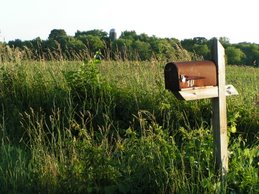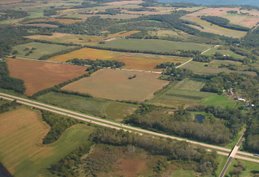I provide my critique of the Stormwater Management Plan under a series of headings, as follows:
1. Failure to take the Watershed into Account. The Nine Springs Creek Watershed and the Swan Creek Watershed are smaller components of the Lake Waubesa Watershed. The Lake Waubesa Watershed, with a principal contribution to it by the City of Fitchburg, is the primary surface hydrologic feature of the “Northeast Neighborhood.” The very critical and far-reaching failure in the Stormwater Management Plan, as produced by the firm of Ruekert/Mielke Engineering firm of Milwaukee, is its total neglect and absence of any recognition of the Lake Waubesa Watershed within which the entire designated “Northeast Neighborhood” is located. A principal requirement of any watershed planning effort is that it must be accomplished within the context of the watershed in which it is located. The Ruekert/Mielke Stormwater Management Plan simply does not address this vital context within which any stormwater plan or study must be placed. It therefore does not evaluate in any appropriate manner the very topic of concern: run-off within the specific watershed of which it is a vital component. Put in other words, stormwater run-off is the run-off of stormwater, by definition. And the system within which and through which this water runs—the watershed—must be the central focus of any stormwater run-off plan or study. The Lake Waubesa Watershed, and Lake Waubesa itself, not only are neglected in this study, but the relationship of Lake Waubesa water quality in the context of this storm water runoff study is not addressed.
2. The Stormwater Management Plan is not a Plan. The document produced by Ruekert/Mielke defines itself as a set of “objectives.” While it is true that objectives clearly must be identified as a pre-requisite to the planning process and to the development of a stormwater plan, these objectives by themselves do not in any way constitute a plan. The report therefore does not live up to its name, and the document produced represents a failure in producing a plan of any sort whatsoever. On the contrary, the Ruekert/Mielke document leaves to site-by-site analysis the function of developing site-by-site plans. This is contrary to state-of-the-art land use planning. William B. Honachefsky, in his book, Ecologically Based Land Use Planning, writes for example, “Designers and developers should encourage the local governments to create storm water management authorities that encompass the entire watershed. Although watersheds may include any number of municipalities, the watershed approach is a more accurate and effective means of managing storm water runoff... Developers can contribute to the authority based on runoff quantities and avoid the expense of dealing with the storm water on a site-by-site basis.” Despite this more accurate and more effective means of managing storm water runoff, the “plan” of Ruekert/Mielke advocates a policy to deal with storm water on a site-by-site basis. The Ruekert/Mielke document therefore is not a plan, but objectives that address the pieces of the watershed without considering, or even recognizing, the watershed as a whole. This is a clear violation of the principles of contemporary land use planning and provides no material whatsoever that would allow development plans, or designation of an urban service area, to be enabled.
3. Failure to Use Modeling and Predictive Technology. The document produced by Ruekert/Mielke fails to make use of some principal analytical tools for evaluating runoff, including such techniques as or similar to the Rational Method, the Source Loading and Management Model (SLAMM), and the Storm Water Management Model (SWMM) as summarized for example by the Minnesota Pollution Control Agency at http://www.pca.state.mn.us/publications/swm-ch8.pdf.
4. Failure to recognize and analyze specifically phosphorus loading. Phosphorus is the principal pollutant of concern to the watersheds of Swan Creek, Nine Springs Creek, and to the Lake Waubesa Watersheds. Yet this is very insufficiently recognized and insufficiently dealt with in the Ruekert/Mielke storm water study. It is critically important, and its being passed over lightly is a major deficiency in evaluating the impacts of extending the urban service district to include the “Northeast Neighborhood” and to moving in the direction of permitting residential development in this area and its special and vitally sensitive watersheds of Swan Creek, Nine Springs Creek and the Lake Waubesa Watershed of which they are intrinsically a part.
5. Failure to do the storm water study in the context of a water balance for the region and for the City of Fitchburg. While likely inclusion of a water budget of the region and city was not part of the mandate given Ruekert/Mielke, it is a serious oversight. It is an oversight similar to addressing withdrawals from a savings account (groundwater being the balance or bottom line) and only one of two major withdrawals being studied and considered. Large scale municipal wells are also a major means of export of water from the region and the City of Fitchburg and must be considered in sum. Moreover, these withdrawals must be part of a water budget that also includes “deposits”—recharged water to the system. The recharge is addressed in the Ruekert/Mielke report, but only in terms that indicate that deposits to the groundwater would be made one of the objectives of any proposed development. But this does not address the water budget and the water balance. Large withdrawals—by runoff and municipal well pumpage—will not be compensated by small deposits. The withdrawals and deposits must be kept in balance for the “bottom line” to remain sustainable—the “bottom line” being the level of the water table. Managing a savings account by only looking at one of two major kinds of withdrawals, and by only saying that deposits will be made but without saying whether these will match the total withdrawals, is poor accounting, and poor economics. More than that, it has immense consequences on the near and more distant future. Already it means that some spring flows have been substantially reduced. This will continue and expand to include additional spring flows that will degrade regional natural resources, and do this very substantially.
6. Failure to address Eutrophication of Lake Waubesa. A primary purpose for a stormwater runoff plan is to prevent downstream eutrophication from occurring as a consequence of urban development. This purpose is wholly neglected in the Ruekert/Mielke report, and yet is most vital to the City of Fitchburg and to the region in which it resides. Eutrophication of Lake Waubesa has occurred in the past, first with the outfall of treated sewage into it from the Nine Springs Sewage Treatment plant operated by MMSD—a problem solved by the diversion of this outfall through a by-pass aqueduct that re-routed the effluent to Badfish Creek, and second with the conversion of cottages on septic tanks to year-‘round homes on Lake Waubesa—a problem solved by building sanitary sewers in the floor of Lake Waubesa on the east and west and pumping effluent, once going to leaking septic systems, to the Nine Springs Sewage Plant. A third effort was the successful defeat of a proposal to build a waste-disposal landfill site on the westerns shore of Lake Waubesa by Costain of England that using “state of the art,” “best engineering practice” would have put 300 gallons of leachate into Lake Waubesa daily via groundwater inflow. Thus, the failure of the Ruekert/Mielke study to address eutrophication, particularly in the light of their generic recognition in their report of the negative impact of urban development on surface waters, puts their report into a highly doubtful status as supporting additional urban development.
These six are among the most major deficiencies and failures of the Ruekert/Mielke report, and are fully sufficient not to use it as a basis to approve extension of urban services or residential and business development in the “Northeast Neighborhood.”
Sincerely,
Calvin B. DeWitt
Professor
Gaylord Nelson Institute for Environmental Studies
Member of the Graduate Faculties of
Land Resources
Water Resources Management
Conservation Biology and Sustainable Development, and
Limnology and Marine Science
Saturday, July 21, 2007
Professor DeWitt Critiques NEN Stormwater Plan
Posted by
West Waubesa Preservation Coalition
at
10:52 PM
![]()
Categories Cal DeWitt, NEN, NEN Stormwater Plan, Ruekert-Mielke



2 comments:
This is a wonderful analysis of the shortcomings of the Stormwater Management Plan.
I hope that the city planners and officials take note of what's missing and insist on more information before proceeding!
Post a Comment